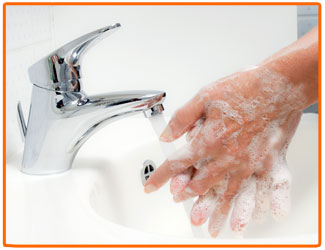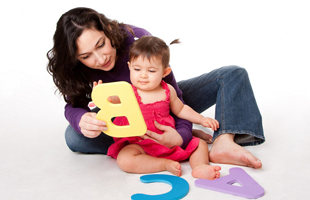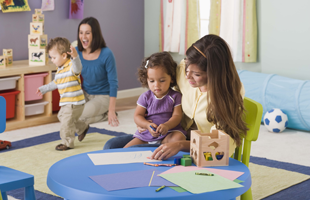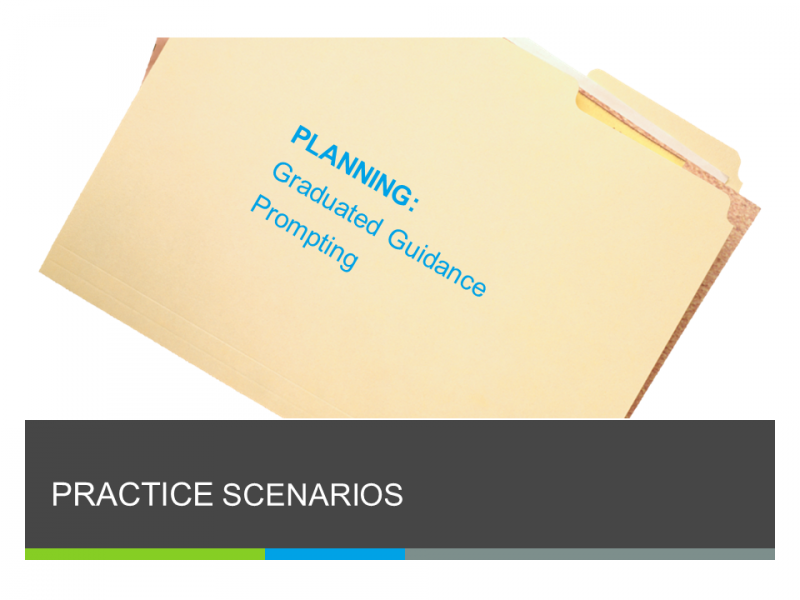Graduated Guidance Prompting Procedure
With graduated guidance, practitioners provide a controlling prompt, a prompt that ensures the toddler will use the skill correctly, and then gradually remove the prompt during a learning activity or routine. This procedure differs from other prompting procedures because it requires practitioners to make judgments during the learning activity or routine about the type and amount of prompting to provide based upon the toddler’s response.
Graduated Guidance is one of two prompting procedures included in this module. A variety of prompting procedures support the learning and development of toddlers with autism spectrum disorders (ASD).
Review information on both prompting procedures covered in this learning module and information on determining which prompting procedure is the most appropriate for an individual toddler and the type of target skills or behaviors you wish to teach.
Step 1 Planning
![]()

The first step for Graduated Guidance Prompting involves planning the intervention. Graduated Guidance requires many moment-to-moment decisions about when to apply and fade the prompts. As the toddler begins to acquire or use the skills, the prompts are faded (reduced and gradually withdrawn), but quickly reinstated if toddler regresses or stops using the skills. If the prompts are not faded appropriately, toddlers can become prompt dependent. Thus, using graduated guidance requires considerable skill.
Graduated guidance is used only with chained tasks or skills within an activity or routine that includes a physical component.
A chained task or routine requires a number of individual skills or behaviors which are sequenced together to form a more complex skill. With these types of skills, numerous steps comprise one completed task.
Step 1.1 Select and describe the target skills or behaviors
Select and describe the target skills or behaviors in the chained activity or routine.
a. Define the target skill or behavior in observable and measurable terms
Beginning with the IFSP, the EI team discusses with the parent the strengths and challenges of the toddler in meeting a priority outcome that includes a chained task or behavior. The IFSP outcome should be written in an observable and measurable way in order to be able to clearly describe the expected skill that the toddler will learn and how to determine when the toddler has mastered the skill.

The target skill is described as “complete self-care routines.”
This is not observable without a description of the actual self-care routine and what would be expected of the toddler. Furthermore, the activities and routines are not specified. The team will need to clearly describe WHEN will the target skill be performed, WHAT the actual skill or skills that the toddler will demonstrate, and HOW the EI team will know Charlie has mastered this skill.
The IFSP team re-writes the outcome so that it is observable and measurable using a WHEN, WHAT,and HOW format.
The re-written IFSP outcome: When Charlie has finished eating a meal or snack at the table (WHEN), Charlie will place his plate, cup and spoon on the counter and throw away his napkin to clear his place at the table (WHAT), 3 out of 4 opportunities for 4 out of 5 days (HOW the EI team will know).
The routines or activities are now described. The target skills are observable and can be measured.
b. Identify the number and sequence of steps in target skill or behaviors of the chain
This can be accomplished by using one of the following methods:
- using a sequence of steps from a curriculum;
- observing a typical toddler performing the chain and writing down the steps;
- asking the parent to help their toddler perform the chain and writing down the steps; or
- performing the chain yourself and writing down each step.
 Video: Example of a Chained Task
Video: Example of a Chained Task
c. Decide if you will teach one step at a time or teach all the steps at the same time.
In most cases, teaching the chain in the sequence is preferred.
Step 1.2 Identify a specific activity or routine to teach
Since the target skills are always chained skills or behaviors, the selection of the activities, routines, and materials will be integrated into identifying the target skills or behaviors.
 The target stimulus should signal the time for using the skill; therefore, teaching should occur when the chain is needed. Using typical routines will allow the toddler to practice the target skills/behaviors frequently throughout the day. The EI team would analyze the day and determine when and where the chained activity is needed. For some chained skills, natural times to teach the chain may be few, so it is important to build in times when the skill may be taught.
The target stimulus should signal the time for using the skill; therefore, teaching should occur when the chain is needed. Using typical routines will allow the toddler to practice the target skills/behaviors frequently throughout the day. The EI team would analyze the day and determine when and where the chained activity is needed. For some chained skills, natural times to teach the chain may be few, so it is important to build in times when the skill may be taught.
EXAMPLE
If you are teaching the toddler to develop a simple play scheme, you would want to identify one or two play opportunities in a day to teach the play skills.
Step 1.3 Identify the target stimulus
Clearly specifying the target stimulus allows the EI team member to be sure that the toddler is attending to the important cues that should, in turn, signal to the toddler that the chained routine or activity is about to begin. This will reduce the toddler’s dependence on an adult’s prompts, usually called prompt dependence.
Categories of target stimuli:
Naturally occurring event
If the target skill is a self-care routine, such as washing hands (because the toddler has been finger painting) then the target stimulus is having dirty hands.
Completing one event or activity
Referencing the example of Charlie completing a clean-up routine (Step 1.1), finishing a meal or snack would be the target stimulus for beginning the clean-up routine.
External signal
An external signal may serve as the target stimulus that could be something that an adult does.

Step 1.4 Select cues or task directions
Identify the event or object that will "cue" the toddler to perform the chained target skill or routine, or use the target behavior.

A cue or task direction is the “bridge” used to help the toddler:
- identify the target stimulus and
- then engage in the target skill or behavior.
The cue or task direction can be verbal or visual.
Material or environmental manipulation:
Materials are set up and ready before toddler begins the chained activity or routine.
If the chained activity is completing a four piece puzzle, the EI provider or parent would place the puzzle on the floor or table with the puzzle pieces placed next to the puzzle. This would signal to the toddler that he is to put the puzzle together.
Naturally occurring event:
These events signal the beginning of the chained skills, behaviors, or routine.
A parent turning on the faucet to fill up the bathtub would signal that it is time to take a bath.
As another example of a naturally occurring event, a child walking through the front door triggers the beginning of the “coming home routine” such as taking off shoes, coat, and washing hands.
Step 1.5 Select reinforcers
Select reinforcers that are appropriate for the individual toddler, the task demands, and the target skill or behaviors.
The goal of reinforcement is to increase the likelihood that the toddler will use the target skill again in the future.
Positive reinforcement refers to the presentation of a reinforcer after a toddler uses a target skill/behavior. Positive reinforcement is generally the strategy that adults use first when trying to teach new skills or behaviors. The reinforcers selected should be highly motivating.
Positive reinforcers can be either primary or secondary.
Primary reinforcers are often naturally reinforcing to toddlers with ASD. Some examples include: food, liquids, and comfort.
However, the value of secondary reinforcers must be learned by pairing primary reinforcers with other types of reinforcement. Some examples of secondary reinforcers include: verbal praise, highly preferred activities, stickers, toys, and edibles. An example of pairing is saying to a toddler, “You did it!” and then the toddler gets a chance to play with a toy. Reinforcers should be highly motivating, naturally reinforcing, and tied to the activity or routine within which the target skill or behavior will be used by the toddler.
With chained skills and the graduated guidance procedure, the completion of the chain is ideally a reinforcer; however, for many learners this is not the case. Thus, additional reinforcers should be used at the end of the chain if this is needed.
Some positive reinforcers include:
- access to a desired or preferred activity/favorite toy (e.g., special job, squishy ball, playing with cars, sand table) or social game (such as peek-a-boo or “so big”)
- specific verbal praise (e.g. “You put the block in!”)
- hugs or physical activity
- access to the preferred food or drink
When choosing reinforcers, the EI team answers the following questions:
- What has motivated the toddler in the past?
- What does the toddler want that he/she can't easily get? This is called the toddler’s deprivation state. For example, a toddler may continually request Goldfish crackers that are placed in a cupboard or on a high shelf; however, the EI provider or parent only gives the toddler the Goldfish crackers once a day. Because the toddler wants the Goldfish crackers, but cannot easily get them, this is considered his deprivation state.
- What reinforcer is appropriate for the target skill and routine or activity? The chosen reinforcer should be as natural as possible and it should be related to the chained routine or activity. For example, it would be natural for a toddler to have access to a preferred or desired activity/object (getting bubbles, listening to a favorite song) after taking part in a challenging activity (learning a play routine).
For more information about how to use positive reinforcement, please refer to the ASD Toddler Initiative module on Positive Reinforcement (ASD Toddler Initiative, 2013).
Step 1.6 Identify the controlling prompt
Identify the controlling prompt or a prompt that ensures that the toddler with ASD performs the target skill or behavior correctly. With the graduated guidance procedure, the controlling prompt is often physical. Controlling prompts should ensure that the toddler
performs the skill or behavior without prompting more than is necessary. Some skills may require more or less restrictive prompting.

For some toddlers the controlling prompt may be as simple as pointing to the faucet to prompt hand washing, while other toddlers may need full hand-over-hand assistance.
Further consideration must be made for toddlers who are not comfortable with touch, light, or heavy touch in particular; or being touched somewhere specific on their body.
EXAMPLE
Continuing with the example of Charlie learning the clean-up routine in Step 1.1A, the EI team decides that the controlling prompt will be hand-over-hand full physical prompt, which will ensure that he picks up the plate to start the clean-up routine.
Step 1.7 Determine the response interval
A response interval is the amount of time to wait after presenting the target stimulus, cue, and task direction before giving the prompt.
With graduated guidance, a short response interval (lasting a couple of seconds) occurs after the delivery of the target stimulus, attending cue, and task direction. As chains are being taught, the response interval is an opportunity for the toddler to start the chain on his/her own. Base the response interval on the individual characteristics of the toddler.

Generally a response interval is between 3 to 5 seconds.
- How long does it take the toddler to complete a similar skill?
- How long does it usually take the toddler to respond when he/she knows how to do the skill? Add a couple of seconds to the usual response time.
- How long does it take another toddler with ASD to use a similar skill?
- What amount of time will the toddler be allowed to begin and complete an activity or routine? This would be important for a chained task or skill such as getting dressed, undressed, washing hands, etc. Some skills in the chain make take longer than the others. In that case, use the longest interval as the response interval.
Step 1.8 Determine how to fade the controlling prompt
Strategies for fading prompts are part of the planning process and, as such, should be discussed prior to implementing the graduated guidance procedures.
 As the toddler becomes more proficient at performing the chained skill, prompt fading strategies will be implemented quickly.
As the toddler becomes more proficient at performing the chained skill, prompt fading strategies will be implemented quickly.
Decisions about fading prompts are made during a trial or teaching session and require “thinking on your feet” about how to change the delivery of the controlling prompt. Consider the intensity or location of the prompt.
One error that is often made is using a more intrusive prompt in the moment when a less intrusive prompt would be as effective. For example. a full physical prompt may also be used when a partial physical might be just as effective.
Understanding how to fade prompts as you are using graduated guidance is critical in decreasing the likelihood that the toddler will become dependent. When the toddler needs the prompt before performing the behavior or skill this can result in prompt dependency.
Guidelines for Fading Prompts
- Fade prompts gradually, systematically, and as quickly as it is determined, through collection of data, that the toddler is responding without the prompts. Graduated guidance requires the adult to make decisions as the child is being prompted within the routine. Collecting data at each teaching moment or trial is necessary in order to effectively fade prompts.
- Increase the response interval gradually to determine if the toddler will respond independently.
- Decrease the intensity of the prompt quickly as you determine that the child is beginning to learn the skill or behavior. Intensity refers to the amount of pressure used when delivering the physical prompts. An example would be moving from complete hand-over-hand instruction to just having your hands on the learner while he or she does the chain.
- Provide less assistance by changing the location of the physical prompt. For example, if you have been providing a physical prompt by using a hand over hand, move the prompt further up the arm.
- Move to less intrusive prompts quickly and as soon as the toddler starts using the skill. Less is better.
- Immediately remove the prompt when it is no longer needed.
Step 1.9 Plan a data collection strategy
Develop a data collection strategy and data collection forms prior to implementing graduated guidance.
At a minimum, data collected should include:
- the steps of the chain that are completed without prompts,
- the steps of the chain that are completed correctly with prompts, including the intensity of each prompt, and
- the steps of the chain that are completed with resistance.
Step 1.10 Gather baseline data
Gather and record baseline data on each step in the chain.
Information on the toddler’s ability to perform each step of the chain (e.g. the baseline performance data) should be collected prior to beginning the use of graduated guidance.
A Graduated Guidance Planning Sheet may be used to record decisions made during planning.
Practice Scenario: Planning Graduated Guidance Prompting
The practice scenario will open in a new browser tab/window.
When you have finished reviewing,
return to the module and take the Knowledge Check.
Knowledge Check
Question:
How do you determine the response interval?
Question:
Describe some considerations in identifying the controlling prompt.
Question:
Describe three considerations when fading prompts.
Step 2 Implementing Graduated Guidance Prompting
![]()

The initial steps involved with using or implementing graduated guidance prompting are: get the toddler’s attention; and present the target stimulus, and the cue or task direction.
Step 2.1 Get the toddler’s attention
Once you get the toddler's attention, present the target stimulus, and the cue or task direction.
Step 2.2 Wait for the toddler to respond
After delivering the cue or task direction, pause and wait for the length the response interval for the toddler to begin the chained task or activity or routine on his own. The controlling prompt is not given until the response interval is over. The only exception would be if the toddler makes an incorrect response (see Step 2.4).
EXAMPLE
Charlie’s mom says, “time to clean up” and gives him his plate. She then waits 3 to 5 seconds, the specified response interval, for Charlie to start moving toward the kitchen counter.
The task direction is "time to clean up."
Step 2.3 Provide the controlling prompt to initiate the chained task
If the toddler does not respond after a short response interval, use the controlling prompt. The adult provides the amount and type of prompt needed to get the toddler to start performing the chain. As soon as the toddler begins to do the chain, adults reduce the intensity or amount of the prompt and start to shadow the toddler’s movements.
Shadowing is a term used to describe the action of holding your hands near the toddler’s hands so you can immediately guide the toddler to complete the behavior.
EXAMPLE
For Charlie, the controlling prompt was identified as hand-over-hand from behind so that Charlie would begin the chain by taking his plate and placing on kitchen counter.
 Video: Shadowing with a Toddler
Video: Shadowing with a Toddler
Step 2.4 Provide additional assistance if needed
Iif the toddler stops, responds incorrectly, or resists, provide additional assistance.
Review the following common challenges and solutions to graduated guidance:
Problem |
Possible Solution |
|
Toddler stops performing the chained step. |
The adult immediately provides the amount and type of prompt needed to get the movement started. |
|
Toddler begins to use the chained skill or behavior incorrectly. |
The adult immediately blocks that movement and provide the amount and type of prompt needed to get the toddler to do the chain correctly. |
|
Toddler resists the type of physical prompt. |
The adult should stop the movement and hold the toddler’s hands gently in place. When the resistance subsides, the adult assists the movement toward completing the step in chain again by applying the type of physical prompt needed. This may include reducing the intensity or location of the physical prompt. |
|
Toddler resists on the last step of the chain. |
The adult does not reinforce the toddler if there is resistance on the last step of the chain. This is to ensure that the toddler is reinforced for the correct behavior. Instead, the adult stops teaching the target skill/behavior until the toddler is no longer resistant. When the resistance subsides, the adult begins teaching the target skill/behavior from the beginning of the chain. |
|
Toddler consistently resists the prompt. |
Graduated Guidance many not be an appropriate approach for this skill or toddler. |
Step 2.5 Verbally praise and encourage the toddler as steps of the chain are completed

As the toddler correctly completes each step of the chain (prompted or unprompted), provide verbal praise and encouragement. At the end of the chain, provide reinforcement to the toddler for completing the task correctly.
Using Prompts with Graduated Guidance
Prompts should focus the toddler’s attention on the target stimulus, not distract from it.
When delivering prompts with Graduated Guidance:
-
Prompts should be as weak as possible.
-
Unplanned prompts should be avoided.
-
Prompts should be faded as quickly as possible.
-
The following are tips for fading prompts:
-
Fading should be determined by monitoring toddler’s unprompted and prompted correct responses
-
Reduce or fade prompts and/or increase the response interval or wait time gradually and systematically.
-
Reduce or fade prompts as quickly as it is determined that toddler is responding without the prompts.
-
If prompts are not faded, prompt dependency can develop. Prompt dependency occurs as result of using prompts when not needed.
Knowledge Check
Question:
What should adults do when they first begin to implement graduated guidance and teach the chained task?
Question:
Describe the key concepts of effective prompting.
Question:
After waiting for the toddler to respond (response interval) and giving the controlling prompt, the toddler initiates the chained activity, but stops.
How should the adult respond?
Question:
How should you respond when the toddler begins to incorrectly respond, use an incorrect behavior, or resists during the chain?
Practice Scenario: Using Graduated Guidance Prompting
The practice scenario will open in a new browser tab/window.
When you have finished reviewing,
return to the module and take the Knowledge Check.
Practice Scenario files:
Center-based Scenario: Caleb in a Center-based Setting
 Video: Graduated Guidance with Caleb
Video: Graduated Guidance with Caleb
Step 3 Monitoring progress
Monitoring progress for graduated guidance prompting involves:
collecting data, reviewing data, and analyzing data to determine if progress is being made.
Step 3.1 Gather and record data
 Gather and record data on the types of prompts and the each type of the toddler’s responses. Each type of response could be correct, incorrect, or no response.
Gather and record data on the types of prompts and the each type of the toddler’s responses. Each type of response could be correct, incorrect, or no response.
An important component of graduated guidance is collecting data to monitor toddler outcomes. You will want to determine who collects the data. This could be the EI provider, parents, child care provider, etc.
When using graduated guidance, the EI team and family should measure at a minimum:
- the steps of the chain that are completed without prompts,
- the steps of the chain that are completed correctly with prompts, and
- the steps of the chain that are completed with resistance.
While not ideal, sometimes it is not possible to score each step of the chain. In such cases, the entire chain is scored as independent, prompted, or resistance. If prompts are given on any chain, it is scored as prompted. If resistance and prompts are given, it is scored as resistance. It would be important to record the intensity and location of the physical prompt.
Sample Data Collection Sheet
Graduated Guidance: Cleaning Up
| Date: 3/28 | Date: 3/28 | Date: 3/28 | |||||
| STEPS IN THE CHAINED TASK: CLEANING UP | Time: 9:00 am | Time: 11:00 am | Time: 2:00 pm | ||||
|
Pick up paper plate |
FP |
FP |
FP |
||||
|
Throws in trash can |
FP |
FP |
PP |
||||
|
Pick up paper cup |
FP |
FP |
FP |
||||
|
Throws in trash can |
PP |
PP |
PP |
||||
|
Pick up napkin |
R |
R |
R |
||||
|
Throws in trash can |
R |
R |
R |
| KEY | ||||
|
I = Independent FP = Full physical prompt PP = Partial physical prompt R = Resistance |
||||
Step 3.2 Select a schedule for data review
Select a schedule for data review and on-going monitoring for prompting.
A schedule for reviewing the data collected will help determine how well the toddler is learning the steps of the chain and to make changes in the prompting procedure are made. This schedule could be every three days or once a week.
Determine which steps are still needing prompts. Then identiify the intensity and location of the prompts and determine the steps where the prompts should be systematically faded.
If a child is resisting during a step of the chain, a plan to determine how to deal with the resistance should be developed.
EXAMPLE
Reviewing the data from the data sheet example given for Cleaning Up in Step 3.1, the child is resisting on the last two steps of the chain. Asking questions about the way the prompt was delivered may clarify why this was happening. It would be appropriate to discuss the techniques for using the controlling prompt, whether the toddler needs more or less intensity, and how to handle resistance (e.g. and if resistance occurs, holding the toddler’s hands in place rather than forcing movement). Reviewing the information allows the team to review how to provide physical prompts (e.g. being careful not to force the toddler when physically prompting). If resistance continues, this may indicate that a different type of prompt or prompting procedure is appropriate.
Step 3.3 Analyze the data
Analyze the data to determine if progress is being made.
This includes which steps are completed without prompts and could, therefore, be either shadowed or independent.
Analysis of the data can help pinpoint problems in implementing the prompting procedure correctly or help make decisions about when the prompting procedure needs to be changed.
Modifications or revisions to the prompting procedure may include:
- changing the type of controlling prompt needed,
- changing the cue or response interval, and
- when to begin fading the prompts.

Data analysis can also help determine which steps are completed without prompts.
- Determine whether these steps are being shadowed or are independent.
- Determine which steps are being prompted, and the intensity and location of the prompts.
Based on the data and using the strategies on how to fade prompts that were discussed in the Step 1.8, remember to reduce intensity or location of the controlling prompt and fade the prompt.
Step 3.4 Use information from data to modify the use of prompting
Use information from data collected to modify, revise or change the use of graduated guidance to enhance acquisition of the target skill or behavior.
Analysis of data can be used to determine if the prompting procedure is being implemented correctly. If it is determined that the prompting procedure is not being implemented correclty, review the steps again for implementation in Step 2 Using Graduated Guidance.
- If the toddler is becoming more skilled in a step in the chain, begin to systematically fade the prompt. Information on how to fade prompts is discussed in Step 1.8.
- If a child is resisting during a step of the chain, develop and implement a plan on how to deal with the resistance.
EXAMPLE

The data from the sample data sheet in Step 3.1, Graduated Guidance: Cleaning Up, shows that the toddler is resisting on the last two steps of the chain.
Asking questions about the way the prompt was delivered may clarify why this was happening. It would be appropriate to discuss the techniques for using the controlling prompt, whether the toddler needs more or less intensity, and how to handle resistance.
In this example, if resistance occurs, hold the toddler’s hands in place rather than forcing movement.
Reviewing the information also allows the team to review how to provide physical prompts. This might include being careful not to force the toddler when physically prompting.
If resistance continues, this may indicate that a different type of prompt or prompting procedure is appropriate.
Knowledge Check
Question:
What basic data should be collected when using graduated guidance prompting?
Question:
What are the benefits to on-going monitoring of the graduated guidance prompting procedure?
Practice Scenario: Monitoring Graduated Guidance Prompting
The practice scenario will open in a new browser tab/window.
When you have finished reviewing,
return to the module and take the Knowledge Check.




